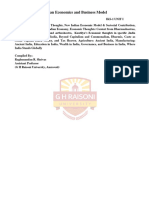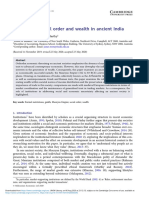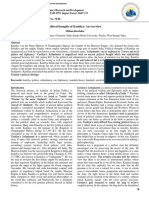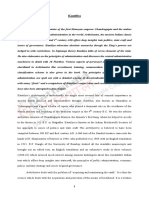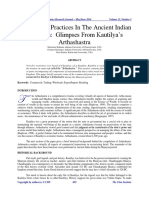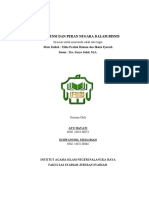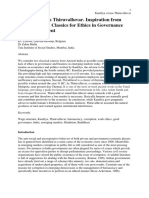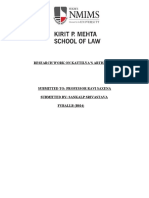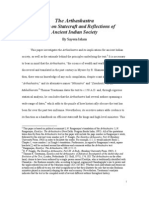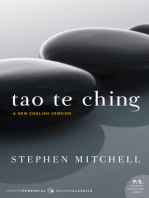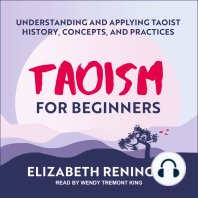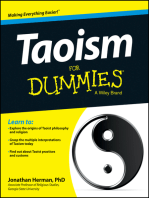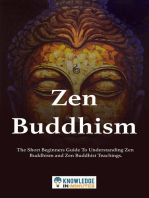Professional Documents
Culture Documents
Relevance of Kautilya Arthashastra in Today's World
Original Title
Copyright
Available Formats
Share this document
Did you find this document useful?
Is this content inappropriate?
Report this DocumentCopyright:
Available Formats
Relevance of Kautilya Arthashastra in Today's World
Copyright:
Available Formats
Volume 6, Issue 9, September – 2021 International Journal of Innovative Science and Research Technology
ISSN No:-2456-2165
Relevance of Kautilya Arthashastra in Today’s World
Samiksha Rajesh Dixit
TYBA, Department of Economics
Fergusson College, Pune, India
Abstract:- This paper aims to highlight the relevance of takes over him. Book 13 deals with the conquering of
Arthashastra and his economic principles in today’s kingdoms, forts and states which consists of five chapters.
economic world. The significance of the study in the field Book 14 consists of 4 chapters and deals with eerie and occult
of economics by Chanakya, the ancient Indian scholar practices. Finally, book 15 consists of organizing a scientific
and administrator of the Maurya dynasty, dated roughly treatise.
between the 4th century BCE and the 3rd century BCE is
noteworthy. Chanakya, also known as Kautilya, wrote an Kautilya Arthashastra’s ideology is based on the theory
important work on economics – Kautilya Arthashastra, of, ‘sam, dam, danda, bhed’, to achieve a certain goal or aim.
the science of wealth, which contains different micro- Many academicians and economists believe that his teachings
aspects of governing such as administration, statecraft and guidelines are ideal for India’s current economic
and military strategy. The Arthashastra was originally problems. The whole treatise is based on relying on dharma
written for Chandragupta Maurya, but today, it is the (to do one’s duties rightfully) and to create a stable structure
most reputed ancient text on economics. He was an for the steady and sustained growth of the nation. He believed
ethical, intellectual, progressive, and far-sighted that without government, the nation will go down the drain.
independent individual who believed in building a Here he implies, that the government should always act for
systematic organizational structure for the peace and the benefit of the people. Kautilya, thus, is the root of Indian
prosperity of his people. Chandragupta Maurya’s era was economics.
stated as ‘The Initiation of Golden Age of India’, with
Chanakya as his advisor. Arthashastra promotes Ethical behaviour is the top-most priority in
yogakshema i.e karma-yoga (dedication towards work), Chanakya’s Arthashastra. The right ethics and proper conduct
dhyana-yoga (contemplation and meditation) and bhakti- can help a nation maintain the law and order and create
yoga (devotion towards the supreme) for the betterment of wealth which in turn will benefit the nation economically.
humanity. Kautilya regarded natural resources and livestock to be of
utmost importance for any economy. He believed that proper
Keywords:- Chanakya, Kautilya Arthashastra, Economics, management of these resources could help in the betterment
Administration. of economic condition of the nation. He stood by the fact that,
‘humans are a part of nature’ and the growth and progress
I. INTRODUCTION will take place when there is proper management and
optimum utilization of natural resources. In Chanakya’s
The Arthashastra is an ancient Indian text on statecraft, times, trade and commerce were flourishing and he had fixed
administration policy and economics. The treatise together the prices and trade regulations according to the demand and
contains 15 books, 150 chapters, 180 topics and provides a supply of the commodities. Taxes were applicable on income
detailed analysis of administration and a thorough knowledge based on one’s ability to pay. Taxes were imposed on land,
of practical problems a government can face, also mentioning trade and industries. CSR was also a key factor in his
the ways of tackling them. Book 1, comprises of 21 chapters administration. During his times, when Kautilya acted as the
consisting of the training of officials and soldiers. Book 2 is advisor of King Chandragupta Maurya, every responsibility
made of 36 chapters speaking about the job of was handed to a chief superintendent who had to protect the
superintendents. Book 3 is on justice, punishment and subjects under his jurisdiction and make sure everything was
rewards. Book 4 covers the topics related to subduing the working smoothly. Time management was also a very
crime rates and maintaining control over traders and important factor in the Arthashastra and was equally assigned
merchants. Book 5 consists mainly of the division of salary of for each task. Commensuration is a very important law
officials, labours and workers. Book 6 is made up of two created by Chanakya; every offence had a certain degree of
chapters that consist of theory about foreign policy and the punishment according to its intensity. He also states in the
integral elements of state policy. Book 7 consists of eighteen book that, women should be allowed to work and there
chapters based on the six-fold strategy, that is, the usage of should be no gender-based discrimination whatsoever. There
foreign policy in various conditions that could likely arise in were rules and regulations for every act performed by an
some situations. Book 8 covers the subject of calamities and individual to help him/her lead a peaceful and prosperous life.
it consists of 5 chapters. Book 9 contains 7 chapters on how
to prepare for the battle. Book 10 speaks about the war tactics
and strategies. Book 11 has one chapter explaining how one
should handle the confederacy in the state. Book 12 assesses
the weaker king and what happens when the stronger one
IJISRT21SEP776 www.ijisrt.com 782
Volume 6, Issue 9, September – 2021 International Journal of Innovative Science and Research Technology
ISSN No:-2456-2165
II. LITERATURE REVIEW IV. RELEVANCE OF CHANAKYA NEETI IN
CURRENT PROBLEMS OF THE WORLD:
Kautilya was a shrewd businessman and had all the
abilities to run a state. He developed many economic policies The Arthashastra is a framework to benefit the top
and a scientific treatise about administration and statecraft. management of the nation for a peaceful and prosperous
His approach towards economics was holistic yet logical to administration. Kautilya lived in an era when monarchy was
bring prosperity to his kingdom. He is the originator of many widespread. Thus, his writing reflects some of the
ideologies and concepts that have re-emerged during the monarchical ideologies from the past. Nevertheless,
recent times. Optimum utilization of resources and wealth Chanakya defines, “Economics is the most important aspect
creation were his main objectives. He was of the view that a of development as it provides the basis for human existence
king is no one without his subjects. He established good and survival”. Kautilya believed that, the king has no
governance in his state which led to one of the most powerful individuality of his own and should work in the interest of his
kingdoms India has ever seen. Dr. Hrishikesh Vinod and Prof. subjects. His happiness lies in the happiness of his subjects.
Balbir Sihag have put in great efforts to bring light to this He has covered a comprehensive range of topics such as
subject. taxation, trade policy, price fixation, market ethics,
international and domestic trade, public finance, revenue
III. KAUTILYA’S ECONOMIC THEORIES AND creation, interest and profit, war and peace, consumer rights,
MODERN ECONOMICS: crime and protection, government expenditure, economic
growth, flexible labour laws etc. He created a path for
Today, India has adopted a western approach for solving economic prosperity through entrepreneurship and achieving
the current problems, but many of the theories that drive it in any situation. Even though there is a difference in eras,
today’s economics were originated by Chanakya. his ideologies are relevant in today’s global environment.
Arthashastra is the first known authentic text on public
Kautilya’s Economic Theories: Kautilya’s economic finance, administration and fiscal laws for the state.
theories were based on ethics. He explained the importance of
ethics and rightful conduct and its benefits to society. The Chanakya was familiar with the theory of demand and
Arthashastra explicitly promotes the goals of both artha supply, the utility of the commodities and its collaborated
(material wellbeing) and dharma (righteous behaviour) as a effect on price determination. He ensured there was no
consistent whole and rejects any divergence from them. hoarding and such other mal-practices happening in the
market so that the prices of commodities did not soar high or
Ethics and rightful conduct were the topmost priority for plunge. He even defined the term ‘future price’, that is, what
Chanakya; he believed that it the way to peace and prosperity. we call in today’s terms as ‘carrying costs’.
He suggested that children should be taught ethical values at
an early age by giving them dharmic lessons from the Vedas Chanakya quotes, “a king must collect taxes like a
(sacred text of Hindu culture). His whole treatise is built on honeybee, enough to sustain but not too much to destroy”.
an ethical foundation and trust in a socially desirable The collection of taxes was well structured and were
perspective. According to him, a society based on morals, collected from all possible sources to provide and protect the
ethics and compassion is productive and less anxiety-prone. state and the king from all the external factors. Sales tax,
Trust plays a critical role and is the most valued possession in income tax, centralised tax and pilgrimage tax collected from
a knowledge-based economy. Sharing and creating all potential sources were spent on social services like
knowledge to incentivize the potential gains from trade is building the roads, setting up educational institutions, funding
built by ethical trust. and building new villages and other activities that would
benefit the kingdom. Land revenue was the most important
Classical Economics: Adam Smith, the father of modern source of tax collected in the state. He insisted on collecting
economics, explains that the best economic benefit can be taxes from farmers who owned arable lands. Kautilya
attained when individuals act in their self-interest. The believed that poverty was a living death and asserted that
Invisible Hand Theory proposes that when consumers act in maintaining law and order was needed for economic
their self-interest, decisions in a free-market economy can prosperity.
make a positive impact on the economy at large. A self-
seeking economy which has adopted a ‘scheming’ approach He stated that productive economic activity and
for trust, treats the trust as a risk and a safeguard against the maximization of utility was the way to a nation’s economic
potential harm that might be caused by the ally’s growth. He believed that the government should watch over
opportunistic view. He set forth the systems of capitalist some of the activities taking place in the state so as to
production, free markets and value. Modern economics maintain the welfare and prosperity of the nation. He
believes that the government should not take participation in highlighted the importance of agriculture in a country and his
business unless to protect the free-market economy. treatise proves to have a solution to many of the problems
faced by India today. Agriculture was the topmost priority as
it was the primary source of revenue creation. Therefore,
creating more opportunities and starting new agriculture
initiatives for a good harvest was important for the state’s
treasury. There were laws fixed regarding the tenure of the
IJISRT21SEP776 www.ijisrt.com 783
Volume 6, Issue 9, September – 2021 International Journal of Innovative Science and Research Technology
ISSN No:-2456-2165
labourers. Labour wages varied according to the productivity These three sustainable parameters have been observed
of the individual. He designated methods for income fixation. in the governance of countries that have evolved to be the
Water management is one of the most important topics developed countries in today’s times. The king was at the
discussed by Kautilya in his work. There were taxes and apex of the administration of law and justice. Good
irrigation facilities all over the kingdom and improvement of governance can create a positive impact on the economy and
the facilities took place every three to five years. future growth of the nation. Policies related to economic
growth, risk management, self-insurance, monopoly
International trade and possession of territory to acquire regulations, preventive measures to deal with natural
sources of food and raw materials led to wars to protect the calamities, national security are some of those that are very
kingdom and trade routes. Therefore, Kautilya says, the much reliable and relevant in today’s world. Human security,
treasury should be maintained at a comfortable level and have regulations, ethics and dharmic values constitute the overall
a reserve of resources for the war period. Despite this, peace development of the nation. The code of ethics is the foremost
was always in favour above war, as peace can lead to requirement for sustained and steady growth of the country.
productivity and abundance. He anticipated the economic He insisted on educating the children for the sustainable
gains and prosperity of the trading kingdoms and encouraged economic development of the state. Education adds value to
international trade. The institutions and companies that one’s understanding and improves the quality of life. His
generate revenue and made good profits were important for several ideas were later utilized by modern economists to
the development of the society. He knew, higher the risk and advocate the development of the country. Even though there
uncertainty, higher were the profits and interests. He are many parallel concepts and principles in modern
suggested development and maintenance of trade routes to economics, Kautilya’s Arthashastra is studied all over the
ensure smooth trade. Kautilya was the first known person to world for its profound knowledge on administration,
put forward the theory of ‘just price’ meaning, the incentive statecraft and economic philosophy and its relevance in
for business people to keep five per cent to ten per cent of today’s world.
profit in their businesses.
V. CONCLUSION
During the Mauryan era, there was no restriction on the
supply of money. The restriction was decided upon the The Arthashastra is an original treatise explaining all the
availability of the metals- gold and silver, used for minting practical problems and setting guidelines for the management
the coins. He even advocated the theory of banking that kept of the kingdom or state. The work has been recognized as one
the wealth of the traders, artisans and merchants in of the most treasured treatises on statecraft, administration and
safekeeping. He made sure to appoint reliable, loyal and economic philosophy. Even though he did not write a book on
honest people for such money-keeping jobs for the bank to be economics, he has explained his ideas implicitly and has
successful. highlighted many ideologies that are required for managing
the affairs of the state. Even after 2000 years, the relevance of
He structured the rates of interest based on the type of Arthashastra in today’s modern economic world shows,
loans offered. Loans were offered and interests were waived visionaries can positively impact the world at any given point
off based on ability to pay and the type of people taking the in time.
loans. The businessmen dealing with forest products had to
pay double interest on their loans, and the traders who REFERENCES
engaged in overseas trade had to pay the highest interest. He
justified the creation of wealth for establishing a welfare [1]. Kautilya’s Arthashastra, Jaico Publishing House,
state. He has written in brief about the type of officials that December 2009.
could cause loss to the treasury. He has even tried to deal [2]. Joshua J. Mark, Arthashastra, World History
with the corruption in the government by speaking about Encyclopedia, June 2020.
morals and ethics and suggests engaging, honest and virtuous [3]. Andrew Beattie, A Brief History of Economics,
staff based on the character reference for the important Investopedia, July 2021.
matters of the council. [4]. Kautilya: The True Founder of Economics, Vitasta
Publications, 2014.
He marked upon three parameters that could measure [5]. Hrishikesh D. Vinod, The Handbook of Hindu
the governance quality: Economics and Business, April 2013.
1. Accountability [6]. L.N Rangarajan, Kautilya: The Arthashastra, Penguin
2. Integrity and India, 1992.
3. Transparency. [7]. Saurabh Singh Roy, Kautilya’s Arthashastra and
‘Modern Economics’, SSRN Electronic Journal,
January 2018.
[8]. Shruti R. Panday, Exploring Chanakya’s Relevance in
Modern Economic Spheres, IJCRT, March 2018.
IJISRT21SEP776 www.ijisrt.com 784
You might also like
- Contemporary Relevance of Kautilya PDFDocument4 pagesContemporary Relevance of Kautilya PDFMithun VasanthaKumarNo ratings yet
- Sanskruti Suryawanshi PSDocument15 pagesSanskruti Suryawanshi PSMeena SuryawanshiNo ratings yet
- History PROJECTDocument29 pagesHistory PROJECTANANYANo ratings yet
- Kautilya'S " Arthashastra" and Modern EconomicsDocument6 pagesKautilya'S " Arthashastra" and Modern Economicsamiya anandNo ratings yet
- Chanakya's Arthashastra and HRMDocument25 pagesChanakya's Arthashastra and HRMSantosh Bagwe67% (6)
- Chapter 2 - PHD ThesisDocument23 pagesChapter 2 - PHD ThesisSteffi YadavNo ratings yet
- 18bec64c U5Document19 pages18bec64c U5Usa ShowsNo ratings yet
- Admin ProjectsDocument12 pagesAdmin Projectsparul priya nayakNo ratings yet
- Kautilyas Arthashastra Art of GovernanceDocument5 pagesKautilyas Arthashastra Art of GovernancearmsfopNo ratings yet
- ArthashastraDocument17 pagesArthashastragitaNo ratings yet
- Kautilya On Leadership: Lessons From Arthashastra: AbstractDocument8 pagesKautilya On Leadership: Lessons From Arthashastra: AbstractNarendra KumarNo ratings yet
- Arthashastra 1Document6 pagesArthashastra 1api-3719593100% (1)
- Governance & Morals: in Perspective of Kautilya's ArthashastraDocument6 pagesGovernance & Morals: in Perspective of Kautilya's ArthashastraSuresh MurtyNo ratings yet
- Arnab Chaudhary - Good Governance - 4th YearDocument10 pagesArnab Chaudhary - Good Governance - 4th YearArnab ChaudharyNo ratings yet
- Chanakya ManagementDocument10 pagesChanakya ManagementJiten_Pujara_8230% (1)
- Studying Kautilya's ArthshastraDocument11 pagesStudying Kautilya's ArthshastraMithil SharmaNo ratings yet
- Good Governance and RtiDocument56 pagesGood Governance and RtiUjjawal ChaudharyNo ratings yet
- Kautilya: Arthashastra and Its Relevance To Modern Day IndiaDocument6 pagesKautilya: Arthashastra and Its Relevance To Modern Day Indiasunru24No ratings yet
- Q) Discuss Kautilya's Views On Theory of State. How It Is Relevant Today?Document4 pagesQ) Discuss Kautilya's Views On Theory of State. How It Is Relevant Today?surbhi sharmaNo ratings yet
- Kautilya PresentationDocument1 pageKautilya PresentationSantoshNo ratings yet
- Bba Iks Notes Sem I Unit I W 23Document38 pagesBba Iks Notes Sem I Unit I W 23RaghuNo ratings yet
- Institutions Social Order and Wealth in Ancient IndiaDocument14 pagesInstitutions Social Order and Wealth in Ancient IndiaNirvan GuptaNo ratings yet
- History-I 2021ballb33Document20 pagesHistory-I 2021ballb33shivam nishadNo ratings yet
- 4 2 54 216Document3 pages4 2 54 216Laksh JainNo ratings yet
- Unit 3Document8 pagesUnit 3ASHNo ratings yet
- Kautilya & Business EthicsDocument15 pagesKautilya & Business Ethicssrimansaumya100% (2)
- Arthashastra Lessons For Management Theory - ManagementDocument5 pagesArthashastra Lessons For Management Theory - ManagementAniket MukherjeeNo ratings yet
- 146536852401.ET - Kautilya Rumki BasuDocument17 pages146536852401.ET - Kautilya Rumki BasuTechnical MukulNo ratings yet
- Political Thoughts of Kautilya: An OverviewDocument4 pagesPolitical Thoughts of Kautilya: An OverviewrogowiNo ratings yet
- Economics Class 11 Economics em From 2006Document212 pagesEconomics Class 11 Economics em From 2006ankulNo ratings yet
- Kautilya Public AdministrationDocument2 pagesKautilya Public AdministrationbansalNo ratings yet
- A Project Report On: "Skill Development"Document26 pagesA Project Report On: "Skill Development"Ravi PatilNo ratings yet
- Evolution of Indian AdministrationDocument36 pagesEvolution of Indian AdministrationAdrian Watts71% (17)
- Commercial Practices in The Ancient Indian Peninsula: Glimpses From Kautilya's ArthashastraDocument6 pagesCommercial Practices in The Ancient Indian Peninsula: Glimpses From Kautilya's Arthashastraamiya anandNo ratings yet
- Kautilyas Arthasastra and Its Impact On Indian Judicial System History ProjectDocument23 pagesKautilyas Arthasastra and Its Impact On Indian Judicial System History ProjectMuppana NikhilaNo ratings yet
- International Journal of Management (Ijm) : ©iaemeDocument7 pagesInternational Journal of Management (Ijm) : ©iaemeIAEME PublicationNo ratings yet
- NOTES "Kautilya's Arthashastra"Document4 pagesNOTES "Kautilya's Arthashastra"Uma SinghNo ratings yet
- Untitled DocumentDocument6 pagesUntitled Documentyasinrakib99No ratings yet
- Meenu Project FinalDocument32 pagesMeenu Project FinalSreedaananthu KunnathNo ratings yet
- Introduction of Kautilya's ArthashastraDocument3 pagesIntroduction of Kautilya's ArthashastraJaideep100% (1)
- A. SRCC - Proposal On Distinguished Speakers ForumDocument18 pagesA. SRCC - Proposal On Distinguished Speakers ForumshubhamgaurNo ratings yet
- Makalah Etika Profesi - Kel XDocument19 pagesMakalah Etika Profesi - Kel Xayu hayatiNo ratings yet
- 5.3.1. Kautilya and The Concept of Good GovernanDocument7 pages5.3.1. Kautilya and The Concept of Good GovernanThangam poojaNo ratings yet
- Mukherjee REVISITINGGOODGOVERNANCE 2010Document7 pagesMukherjee REVISITINGGOODGOVERNANCE 2010ALEENA ELIZABETH JOBYNo ratings yet
- Comparison Between Kautilya Nad MachiavelliDocument10 pagesComparison Between Kautilya Nad MachiavelliKushal KediaNo ratings yet
- Kautilyas Saptanga TheoryDocument11 pagesKautilyas Saptanga TheorySaket MehtaNo ratings yet
- Kautilyan Mandala Theory International RDocument16 pagesKautilyan Mandala Theory International RMoumita SinghaNo ratings yet
- Classical Hindu Conception of StateDocument3 pagesClassical Hindu Conception of Statenyxxerxes1No ratings yet
- IntroductionDocument6 pagesIntroductionChitrakshiNo ratings yet
- Iipt PyqsDocument10 pagesIipt PyqsNikita SahooNo ratings yet
- Thiruvalluvar Kautilya Mulla de Vylder 2 PDFDocument16 pagesThiruvalluvar Kautilya Mulla de Vylder 2 PDFHemaNo ratings yet
- Sem 2 Research WorkDocument6 pagesSem 2 Research WorkSankalp SRIVASTAVNo ratings yet
- Financial Management Lessons From KautilyaDocument3 pagesFinancial Management Lessons From Kautilyak gowtham kumarNo ratings yet
- Public Administration Unit-4 Evolution of Public AdministrationDocument9 pagesPublic Administration Unit-4 Evolution of Public AdministrationDeepika Sharma100% (3)
- The ArthashastraDocument2 pagesThe ArthashastrarajsimariaaNo ratings yet
- The ArthashastraDocument11 pagesThe ArthashastraGaurav100% (1)
- Kumar Structureprinciplespublic 2005Document27 pagesKumar Structureprinciplespublic 2005Arun JangidNo ratings yet
- Digital Finance-Fintech and it’s Impact on Financial Inclusion in IndiaDocument10 pagesDigital Finance-Fintech and it’s Impact on Financial Inclusion in IndiaInternational Journal of Innovative Science and Research TechnologyNo ratings yet
- An Overview of Lung CancerDocument6 pagesAn Overview of Lung CancerInternational Journal of Innovative Science and Research TechnologyNo ratings yet
- Impact of Stress and Emotional Reactions due to the Covid-19 Pandemic in IndiaDocument6 pagesImpact of Stress and Emotional Reactions due to the Covid-19 Pandemic in IndiaInternational Journal of Innovative Science and Research TechnologyNo ratings yet
- Utilization of Waste Heat Emitted by the KilnDocument2 pagesUtilization of Waste Heat Emitted by the KilnInternational Journal of Innovative Science and Research TechnologyNo ratings yet
- Ambulance Booking SystemDocument7 pagesAmbulance Booking SystemInternational Journal of Innovative Science and Research TechnologyNo ratings yet
- Auto Tix: Automated Bus Ticket SolutionDocument5 pagesAuto Tix: Automated Bus Ticket SolutionInternational Journal of Innovative Science and Research TechnologyNo ratings yet
- Designing Cost-Effective SMS based Irrigation System using GSM ModuleDocument8 pagesDesigning Cost-Effective SMS based Irrigation System using GSM ModuleInternational Journal of Innovative Science and Research TechnologyNo ratings yet
- An Industry That Capitalizes Off of Women's Insecurities?Document8 pagesAn Industry That Capitalizes Off of Women's Insecurities?International Journal of Innovative Science and Research TechnologyNo ratings yet
- Impact of Silver Nanoparticles Infused in Blood in A Stenosed Artery Under The Effect of Magnetic Field Imp. of Silver Nano. Inf. in Blood in A Sten. Art. Under The Eff. of Mag. FieldDocument6 pagesImpact of Silver Nanoparticles Infused in Blood in A Stenosed Artery Under The Effect of Magnetic Field Imp. of Silver Nano. Inf. in Blood in A Sten. Art. Under The Eff. of Mag. FieldInternational Journal of Innovative Science and Research TechnologyNo ratings yet
- Predictive Analytics for Motorcycle Theft Detection and RecoveryDocument5 pagesPredictive Analytics for Motorcycle Theft Detection and RecoveryInternational Journal of Innovative Science and Research TechnologyNo ratings yet
- Forensic Advantages and Disadvantages of Raman Spectroscopy Methods in Various Banknotes Analysis and The Observed Discordant ResultsDocument12 pagesForensic Advantages and Disadvantages of Raman Spectroscopy Methods in Various Banknotes Analysis and The Observed Discordant ResultsInternational Journal of Innovative Science and Research TechnologyNo ratings yet
- Computer Vision Gestures Recognition System Using Centralized Cloud ServerDocument9 pagesComputer Vision Gestures Recognition System Using Centralized Cloud ServerInternational Journal of Innovative Science and Research TechnologyNo ratings yet
- Effect of Solid Waste Management on Socio-Economic Development of Urban Area: A Case of Kicukiro DistrictDocument13 pagesEffect of Solid Waste Management on Socio-Economic Development of Urban Area: A Case of Kicukiro DistrictInternational Journal of Innovative Science and Research TechnologyNo ratings yet
- Cyber Security Awareness and Educational Outcomes of Grade 4 LearnersDocument33 pagesCyber Security Awareness and Educational Outcomes of Grade 4 LearnersInternational Journal of Innovative Science and Research TechnologyNo ratings yet
- Study Assessing Viability of Installing 20kw Solar Power For The Electrical & Electronic Engineering Department Rufus Giwa Polytechnic OwoDocument6 pagesStudy Assessing Viability of Installing 20kw Solar Power For The Electrical & Electronic Engineering Department Rufus Giwa Polytechnic OwoInternational Journal of Innovative Science and Research TechnologyNo ratings yet
- Blockchain Based Decentralized ApplicationDocument7 pagesBlockchain Based Decentralized ApplicationInternational Journal of Innovative Science and Research TechnologyNo ratings yet
- Unmasking Phishing Threats Through Cutting-Edge Machine LearningDocument8 pagesUnmasking Phishing Threats Through Cutting-Edge Machine LearningInternational Journal of Innovative Science and Research TechnologyNo ratings yet
- Visual Water: An Integration of App and Web To Understand Chemical ElementsDocument5 pagesVisual Water: An Integration of App and Web To Understand Chemical ElementsInternational Journal of Innovative Science and Research TechnologyNo ratings yet
- Factors Influencing The Use of Improved Maize Seed and Participation in The Seed Demonstration Program by Smallholder Farmers in Kwali Area Council Abuja, NigeriaDocument6 pagesFactors Influencing The Use of Improved Maize Seed and Participation in The Seed Demonstration Program by Smallholder Farmers in Kwali Area Council Abuja, NigeriaInternational Journal of Innovative Science and Research TechnologyNo ratings yet
- Compact and Wearable Ventilator System For Enhanced Patient CareDocument4 pagesCompact and Wearable Ventilator System For Enhanced Patient CareInternational Journal of Innovative Science and Research TechnologyNo ratings yet
- Parastomal Hernia: A Case Report, Repaired by Modified Laparascopic Sugarbaker TechniqueDocument2 pagesParastomal Hernia: A Case Report, Repaired by Modified Laparascopic Sugarbaker TechniqueInternational Journal of Innovative Science and Research TechnologyNo ratings yet
- Smart Health Care SystemDocument8 pagesSmart Health Care SystemInternational Journal of Innovative Science and Research TechnologyNo ratings yet
- Smart Cities: Boosting Economic Growth Through Innovation and EfficiencyDocument19 pagesSmart Cities: Boosting Economic Growth Through Innovation and EfficiencyInternational Journal of Innovative Science and Research TechnologyNo ratings yet
- Parkinson's Detection Using Voice Features and Spiral DrawingsDocument5 pagesParkinson's Detection Using Voice Features and Spiral DrawingsInternational Journal of Innovative Science and Research TechnologyNo ratings yet
- Quantifying of Radioactive Elements in Soil, Water and Plant Samples Using Laser Induced Breakdown Spectroscopy (LIBS) TechniqueDocument6 pagesQuantifying of Radioactive Elements in Soil, Water and Plant Samples Using Laser Induced Breakdown Spectroscopy (LIBS) TechniqueInternational Journal of Innovative Science and Research TechnologyNo ratings yet
- Predict The Heart Attack Possibilities Using Machine LearningDocument2 pagesPredict The Heart Attack Possibilities Using Machine LearningInternational Journal of Innovative Science and Research TechnologyNo ratings yet
- Insights Into Nipah Virus: A Review of Epidemiology, Pathogenesis, and Therapeutic AdvancesDocument8 pagesInsights Into Nipah Virus: A Review of Epidemiology, Pathogenesis, and Therapeutic AdvancesInternational Journal of Innovative Science and Research TechnologyNo ratings yet
- Air Quality Index Prediction Using Bi-LSTMDocument8 pagesAir Quality Index Prediction Using Bi-LSTMInternational Journal of Innovative Science and Research TechnologyNo ratings yet
- Implications of Adnexal Invasions in Primary Extramammary Paget's Disease: A Systematic ReviewDocument6 pagesImplications of Adnexal Invasions in Primary Extramammary Paget's Disease: A Systematic ReviewInternational Journal of Innovative Science and Research TechnologyNo ratings yet
- An Analysis On Mental Health Issues Among IndividualsDocument6 pagesAn Analysis On Mental Health Issues Among IndividualsInternational Journal of Innovative Science and Research TechnologyNo ratings yet
- Quantitative Easing Timeline What Is Quantitative EasingDocument3 pagesQuantitative Easing Timeline What Is Quantitative EasingMohamad soltaniNo ratings yet
- Key Concepts: Ceteris Paribus, P. 70Document3 pagesKey Concepts: Ceteris Paribus, P. 70Wan Muhamad ShariffNo ratings yet
- TT 253Document4 pagesTT 253Saleh AkramNo ratings yet
- Does CEMEX Have A Global AdvantageDocument3 pagesDoes CEMEX Have A Global AdvantageCarla Mairal MurNo ratings yet
- HR List - Establishments - List PDFDocument64 pagesHR List - Establishments - List PDFsanjay sharmaNo ratings yet
- Eurocontrol Lssip 2022 Bosnia HerzegovinaDocument133 pagesEurocontrol Lssip 2022 Bosnia HerzegovinaDeniNo ratings yet
- Value of SupplyDocument35 pagesValue of Supplysaket kumarNo ratings yet
- Chapter 14Document34 pagesChapter 14Pháp NguyễnNo ratings yet
- Mitsubishi Corporation: Midterm Corporate Strategy 2018Document10 pagesMitsubishi Corporation: Midterm Corporate Strategy 2018Sourav ChhabraNo ratings yet
- FAR Mock ExamDocument9 pagesFAR Mock ExamchristineNo ratings yet
- Dokumen - Tips - PPT On Tata Motors Case 8Document17 pagesDokumen - Tips - PPT On Tata Motors Case 8debashreeta swainNo ratings yet
- Hni 72Document1 pageHni 72Arsh AhmadNo ratings yet
- PDF Applied Economics Module 4Document34 pagesPDF Applied Economics Module 4Raiza CabreraNo ratings yet
- Ffa08 - g08 - en (Connecting Fittings)Document118 pagesFfa08 - g08 - en (Connecting Fittings)GetziNo ratings yet
- How To Trade Synthetic Indices. Simple Invest FXDocument14 pagesHow To Trade Synthetic Indices. Simple Invest FXuuguludavid77No ratings yet
- EBCL Notes by Shubham AbadDocument402 pagesEBCL Notes by Shubham AbadpkkavithaaNo ratings yet
- From Industry To Alchemy - Burgmaster A Machine Tool Company PDFDocument408 pagesFrom Industry To Alchemy - Burgmaster A Machine Tool Company PDFLaurence DuterteNo ratings yet
- 【陈茂:词中有真意】第9讲 词汇与词性讲解练习Document7 pages【陈茂:词中有真意】第9讲 词汇与词性讲解练习20231102faxuejiaNo ratings yet
- Accountancy Pre Board 2Document5 pagesAccountancy Pre Board 2Akshit kumar 10 pinkNo ratings yet
- DCE List RevisedDocument1 pageDCE List RevisedAkesh LimNo ratings yet
- Control of The SeasDocument10 pagesControl of The SeasMiki CarNo ratings yet
- Application of Law of SupplyDocument15 pagesApplication of Law of SupplyPranabh KumarNo ratings yet
- 2 Applied AccountingDocument2 pages2 Applied AccountingIbrahim MudassarNo ratings yet
- Liberalization Privatization Globalization Development Private SectorDocument6 pagesLiberalization Privatization Globalization Development Private SectorKen DbrittoNo ratings yet
- Faculty / Dept: Economics Subject Number ECON10003 Subject Name Introductory MacroeconomicsDocument13 pagesFaculty / Dept: Economics Subject Number ECON10003 Subject Name Introductory Macroeconomicsvanessa8pangestuNo ratings yet
- Metric Flat Washers Dimensions & Specs - AFT FastenersDocument1 pageMetric Flat Washers Dimensions & Specs - AFT FastenersMebin CherianNo ratings yet
- Final Term Prep QuestionsDocument15 pagesFinal Term Prep QuestionsBrandyn HamiltonNo ratings yet
- IFRS 9 - Financial InstrumentsDocument37 pagesIFRS 9 - Financial InstrumentslaaybaNo ratings yet
- Radha Sridhar - 2 - 2019-2020Document2 pagesRadha Sridhar - 2 - 2019-2020Radha SridharNo ratings yet
- Bachelor Degree in Wildlife ManagementDocument10 pagesBachelor Degree in Wildlife ManagementSimon PargasNo ratings yet
- Mad Monk Manifesto: A Prescription for Evolution, Revolution and Global AwakeningFrom EverandMad Monk Manifesto: A Prescription for Evolution, Revolution and Global AwakeningRating: 5 out of 5 stars5/5 (19)
- The Secret of the Golden Flower: A Chinese Book Of LifeFrom EverandThe Secret of the Golden Flower: A Chinese Book Of LifeRating: 5 out of 5 stars5/5 (4)
- The Essence of the Bhagavad Gita: Explained by Paramhansa Yogananda as remembered by his disciple, Swami KriyanandaFrom EverandThe Essence of the Bhagavad Gita: Explained by Paramhansa Yogananda as remembered by his disciple, Swami KriyanandaRating: 4.5 out of 5 stars4.5/5 (40)
- The Tao of Influence: Ancient Wisdom for Modern Leaders and EntrepreneursFrom EverandThe Tao of Influence: Ancient Wisdom for Modern Leaders and EntrepreneursRating: 4.5 out of 5 stars4.5/5 (9)
- The Essence of Self-Realization: The Wisdom of Paramhansa YoganandaFrom EverandThe Essence of Self-Realization: The Wisdom of Paramhansa YoganandaRating: 4.5 out of 5 stars4.5/5 (43)
- Zen Buddhism: How Zen Buddhism Can Create A Life of Peace, Happiness and InspirationFrom EverandZen Buddhism: How Zen Buddhism Can Create A Life of Peace, Happiness and InspirationRating: 5 out of 5 stars5/5 (5)
- Going to Pieces without Falling Apart: A Buddhist Perspective on WholenessFrom EverandGoing to Pieces without Falling Apart: A Buddhist Perspective on WholenessRating: 3.5 out of 5 stars3.5/5 (112)
- Tao Te Ching: A New English VersionFrom EverandTao Te Ching: A New English VersionRating: 4.5 out of 5 stars4.5/5 (131)
- Taoism for Beginners: Understanding and Applying Taoist History, Concepts, and PracticesFrom EverandTaoism for Beginners: Understanding and Applying Taoist History, Concepts, and PracticesRating: 5 out of 5 stars5/5 (1)
- Shakti Rising: Embracing Shadow and Light on the Goddess Path to WholenessFrom EverandShakti Rising: Embracing Shadow and Light on the Goddess Path to WholenessRating: 5 out of 5 stars5/5 (21)
- Original I Ching: An Authentic Translation of the Book of ChangesFrom EverandOriginal I Ching: An Authentic Translation of the Book of ChangesNo ratings yet
- The Hundred Remedies of the Tao: Spiritual Wisdom for Interesting TimesFrom EverandThe Hundred Remedies of the Tao: Spiritual Wisdom for Interesting TimesRating: 5 out of 5 stars5/5 (2)
- The Eternal Tao Te Ching: The Philosophical Masterwork of Taoism and Its Relevance TodayFrom EverandThe Eternal Tao Te Ching: The Philosophical Masterwork of Taoism and Its Relevance TodayRating: 4 out of 5 stars4/5 (6)
- Swami Vivekananda Echoes of Eternity: America’s 1st Guru in His Own WordsFrom EverandSwami Vivekananda Echoes of Eternity: America’s 1st Guru in His Own WordsRating: 4.5 out of 5 stars4.5/5 (28)
- Alone With Others: An Existential Approach to BuddhismFrom EverandAlone With Others: An Existential Approach to BuddhismRating: 4 out of 5 stars4/5 (30)
- Zen Buddhism: The Short Beginners Guide To Understanding Zen Buddhism and Zen Buddhist Teachings.From EverandZen Buddhism: The Short Beginners Guide To Understanding Zen Buddhism and Zen Buddhist Teachings.Rating: 5 out of 5 stars5/5 (3)
- God As Nature Sees God: A Christian Reading of the Tao Te ChingFrom EverandGod As Nature Sees God: A Christian Reading of the Tao Te ChingRating: 4.5 out of 5 stars4.5/5 (3)























